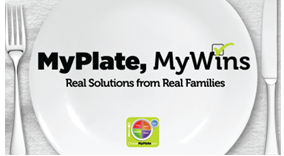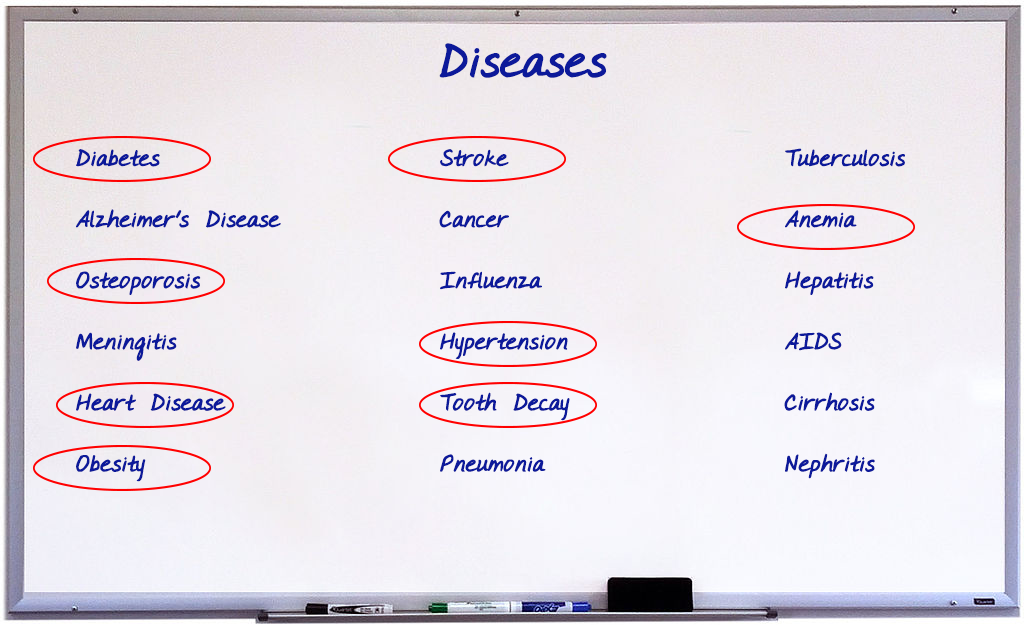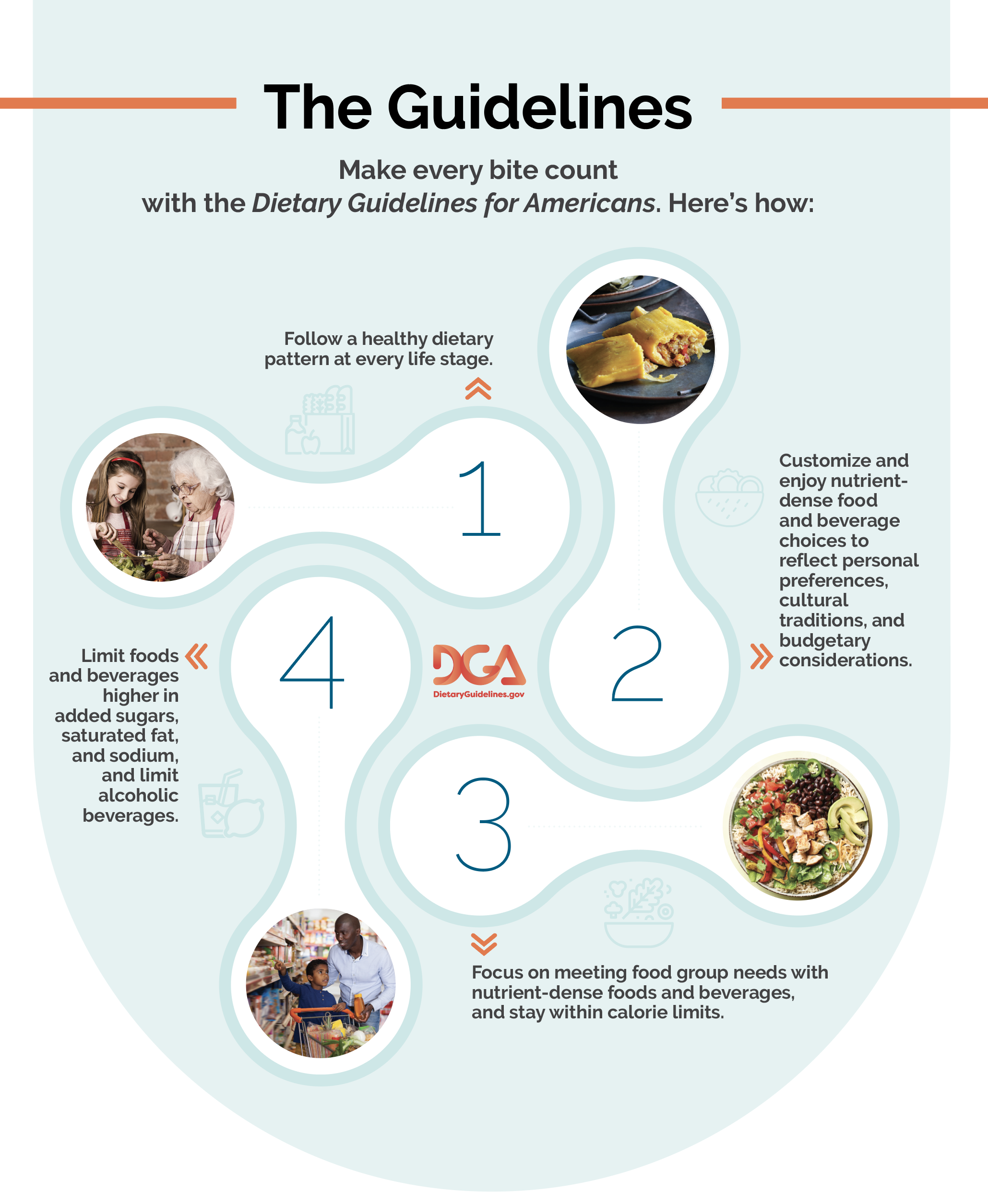Agricultural Literacy Curriculum Matrix
Lesson Plan
MyPlate, MyWin
Grade Level
Purpose
Students will explore the 2020-2025 Dietary Guidelines, compare and contrast historical food guides, and discover how to apply principles of MyPlate into their diet to create a "MyWin." Grades 9-12
Estimated Time
Materials Needed
Engage:
- Dietary Guideline Timeline, 1 copy per class
- Food Guide Timeline, 1 copy per class
Activity 1: What are the Dietary Guidelines
- Dietary Guidelines 101 worksheet, 1 copy per student
- Understanding the Dietary Guidelines for Americans video
- Dietary Guideline Scenarios, 1 copy per class cut into strips
Activity 2: MyPlate, MyWins
- What are #MyPlateMyWins? video
- MyPlate, MyWins: What's Your Healthy Eating Style? video
- Making MyPlate MyWin handout, 1 per student
Vocabulary
Dietary Guidelines for Americans: food-based recommendations to promote health, help prevent diet-related chronic diseases, and meet nutritional needs
MyPlate: nutritional guide published by the United States Department of Agriculture (USDA); icon depicting a place setting with a plate and glass divided into five food groups
United States Department of Agriculture (USDA): a federal agency responsible for developing and executing federal laws related to farming, forestry, and food
Did You Know?
- The first dietary recommendations were offered to Americans by the USDA in 1916.1
- Fast food meal portions are 2-5 times larger today than they were in the 1980s.2
- 45% of millennials and 24% of baby boomers have adopted a special diet (e.g., gluten-free or vegan).3
Background Agricultural Connections
Every five years since 1980 the United States Department of Agriculture (USDA) publishes the Dietary Guidelines for Americans. These guidelines put current nutritional research into context for consumers to create healthy eating patterns, promote health, and reduce the risk for chronic disease. The guidelines also set the standard for national food programs, school lunch menus, and low-income food programs.
The first dietary guidelines were set in place from 1916-1930.1 The informational brochures were titled “Food for Young Children” and “How to Select Food.” Nutritional guidance has continued to evolve and change over the last 100 years.
 Today, dietary recommendations include food groups, recommended serving sizes, overall caloric intake, foods to limit, and foods to eat more of. MyPlate is the current nutrition guide published by the USDA. The image depicts a place setting with a plate and glass divided into 5 food groups. Many challenges exist to incorporate a healthy diet. The MyPlate, MyWins initiative is focused on helping Americans find solutions for healthy eating that matches lifestyle and culture. For example, learning to make healthy choices even while eating out, snacking, or eating local foods.
Today, dietary recommendations include food groups, recommended serving sizes, overall caloric intake, foods to limit, and foods to eat more of. MyPlate is the current nutrition guide published by the USDA. The image depicts a place setting with a plate and glass divided into 5 food groups. Many challenges exist to incorporate a healthy diet. The MyPlate, MyWins initiative is focused on helping Americans find solutions for healthy eating that matches lifestyle and culture. For example, learning to make healthy choices even while eating out, snacking, or eating local foods.
Engage
- Share the following quote with students: “Unless care is exercised in selecting food, a diet may result which is one-sided or badly balanced… The evils of overeating may not be felt at once, but sooner or later they are sure to appear…”5
- Explain that W.O. Atwater said this in 1894. He was a USDA chemist studying nutrition. Explain that the USDA is a government agency that oversees the production of our food supply beginning on the farm and ending on our plates. Continue to explain that the USDA began educating consumers about nutrition over 100 years ago.
- Divide your board in half and label one side “Dietary Guidelines” and the other side “Food Guides.” Explain that the USDA has created lists of nutritional recommendations known as Dietary Guidelines. They have also created graphical images to represent what healthy eating patterns look like. They are called Food Guides.
- Divide your class in half. Give one team the Dietary Guideline Timeline printout and the other team the Food Guide Timeline. Instruct the students to work together to place each historical version of the Food Guide and Dietary Guidelines in chronological order on the board.
- After students have made their best guess, use the key provided in each printout to put both timelines in the correct order and label them with the date.
- Discuss reasons why the recommendations have been updated through the years (scientific research, cultural trends, etc.). Ask students if they can identify any trends that haven’t changed through the years.


Explore and Explain
Activity 1: What are the Dietary Guidelines?
- Ask students to brainstorm a list of diseases. Record them on the board. When you have a sufficient list, circle the diseases that are health/diet related. Once you have circled the diseases, ask students what all of the circled diseases have in common. (they are impacted or caused by the foods we eat) Conclude that the foods we eat impact our lifelong health.

- Give each student one copy of the Dietary Guidelines 101 worksheet.
- Watch the video, Understanding the Dietary Guidelines for Americans. Prior to the video clip, inform students that they will need to be able to tell you the who, what, when, and why of the dietary guidelines. Note: This video was created with the 2015-2020 guidelines. However, it describes the who, what, when, and why questions outlined on the student handout. You can use the video, or explain these concepts yourself.
- After the video, discuss:
- Who? United States Department of Agriculture (USDA) and the US Department of Health and Human Services.
- What? Guidelines to help Americans understand how to have a healthy diet.
- When? Every 5 years.
- Why? To reduce the risk of chronic disease.
- Direct students to their Dietary Guidelines 101 handout. Instruct them to review the four dietary guidelines from the graphic organizer on page two and to read the information found on pages three and four. As students review the information, they should note the questions they have about each dietary guideline as they read. Record the quesitons in the appropriate box on page one.
- Tip: To improve reading comprehension, consider assigning students to highlight everything they should do in one color and everything they should avoid in another color as they read.
- Print one copy of the Dietary Guideline Scenarios and cut each of the scenarios apart. You will have 40 scenarios. Divide your board into four sections and label each with the numbers 1-4 (to represent each of the 4 dietary guidelines).
- To summarize and apply what they have learned, give each student one scenario. Have them read the scenario and place it on the board with the dietary guideline being described. For example, choosing a canned soup with less sodium could be placed with dietary guideline #4 (Limiting foods and beverages higher in added sugar, sodium, etc.) Note that some scenarios can fit into multiple categories.

Activity 2: MyPlate, MyWins
- Ask students what the current food guide is called (MyPlate). (If needed, help them distinguish between the Dietary Guidelines and the Food Guide by remembering that the Food Guide is a graphical image.) Draw on prior knowledge to discuss that MyPlate depicts a plate setting that is divided into 5 food groups and shows portion sizes for each food group.
- Ask students what kind of obstacles they face in following good nutrition principles like those illustrated in MyPlate. Students may offer ideas such as time, eating out, cultural eating preferences, etc. Guide your discussion for students to realize that diet and nutrition is not a one-size-fits-all program. There are many ways to eat healthy.
- Show What are #MyPlateMyWins? video followed by MyPlate, MyWins: What’s Your Healthy Eating Style?
- Project the Shift to Healthier Food and Beverage Choices PDF. Review it as a class. Ask students if small changes can make big differences. (Yes!)
- Give each student one copy of the Making MyPlate, MyWins handout. Students will need access to a computer or device to complete the activity using tools on www.myplate.gov.
Elaborate
-
Explore how to Customize the Dietary Guidelines Framework to consider cultural foodways, budgetary considerations, etc.
-
Following Activity 1, assign student’s to create their own scenarios that follow the Dietary Guidelines.
-
Have students play the MyPlate Match Game to learn the names and colors of the food groups, how to categorize foods by food group, how many servings they need from each group daily, and ways to be active for 60 minutes per day.
-
Assign students to prepare a meal following MyPlate recommendations. Prior to eating, they should take a picture and share on social media using a corresponding hashtag such as #MyPlateMyWins and/or a hashtag specific to your class.
-
Have students watch several of the MyPlate, MyWins videos on USDA’s MyPlate YouTube channel. Analyze and compare the challenges faced by the different people. Discover similarities and differences as well as their healthy eating solutions.
-
Help students customize their own MyPlate Plan based on their individual nutritional needs.
Evaluate
After conducting these activities, review and summarize the following key concepts:
- The Dietary Guidelines are a tool to help Americans make healthy nutritional choices to prevent chronic disease and enjoy a healthy lifestyle. They are updated every 5 years.
- MyPlate is a graphic that illustrates the correct portions of each food group.
- Small shifts in our dietary habits can make big, positive impacts in our lives.
- Being aware of the types of food produced locally helps encourage more healthy eating habits.
Sources
- https://myplate-prod.azureedge.us/sites/default/files/2020-12/ABriefHistoryOfUSDAFoodGuides.pdf
- https://www.depts.ttu.edu/hospitality/pdf/SmartChoices2011_Portion.pdf
- http://www.ift.org/newsroom/news-releases/2014/january/15/13-interesting-facts-about-americas-eating-habits.aspx
- https://www.amiba.net/resources/multiplier-effect/
- https://www.npr.org/sections/thesalt/2016/01/13/462821161/illustrating-diet-advice-is-hard-heres-how-usda-has-tried-to-do-it
Recommended Companion Resources
Author
Organization
| We welcome your feedback! If you have a question about this lesson or would like to report a broken link, please send us an email at matrixelearning@gmail.com. If you have used this lesson and are willing to share your experience, we will provide you with a coupon code for 10% off your next purchase at AgClassroomStore. |
